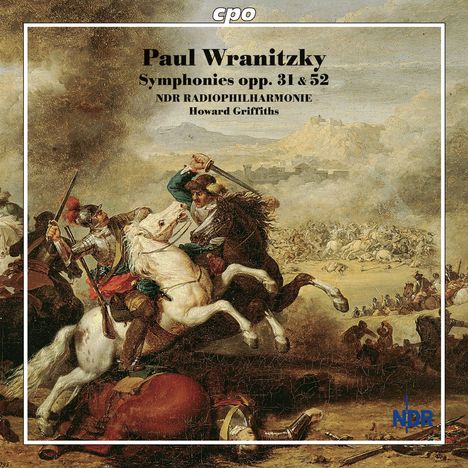Paul Wranitzky: Symphonien opp.31 & 52 auf Super Audio CD
Symphonien opp.31 & 52
Die SACD verwendet eine höhere digitale Auflösung als die Audio-CD und bietet außerdem die Möglichkeit, Mehrkanalton (Raumklang) zu speichern. Um die Musik in High-End-Qualität genießen zu können, wird ein spezieller SACD-Player benötigt. Dank Hybrid-Funktion sind die meisten in unserem Shop mit "SACD" gekennzeichneten Produkte auch auf herkömmlichen CD-Playern abspielbar. Dann allerdings unterscheidet sich der Sound nicht von einer normalen CD. Bei Abweichungen weisen wir gesondert darauf hin (Non-Hybrid).
- Tonformat:
- stereo & multichannel (hybrid)
- Künstler:
- NDR Radiophilharmonie Hannover, Howard Griffiths
- Label:
- CPO
- Aufnahmejahr ca.:
- 2004
- Artikelnummer:
- 3493380
- UPC/EAN:
- 0761203705429
- Erscheinungstermin:
- 12.10.2006
Gleichaltrig mit W. A. Mozart war der mährische Komponist und Violinist Paul Wranitzky um 1800 einer der einflussreichsten und beliebtesten Komponisten der österreichischen Haupstadt. Er war ein ungemein fruchtbarer Komponist, dessen Werke in ganz Europa verbreitet waren, besonderen Ruhm erwarb er sich durch das Singspiel Oberon, König der Elfen, der ersten »Geisteroper« von Bedeutung. Seine Erfolge veranlassten ihn auch, die zunächst gestartete Theologielaufbahn aufzugeben und sich ganz der Musik zu widmen. Ab 1787 war er Mitglied des Burgtheater-Orchesters, dessen Direktor er später wurde. Seine bedeutungsschwangere »Friedens«-Sinfonie »Grande Sinfonie caractéristique pour la paix avec la Republique françoise« op. 31, die er in in einem Beiblatt durch programmatische Titel selber erläuterte, erfreute sich an vielen Adelshöfen großer Beliebtheit, wie man an der weiten Verbreitung der Drucke sieht. Es ist ein Fest der verschiedensten Klangfarben. Ein Schlachtengemälde und – quasi als idée fixe – immer wieder Marschzitate: Wranitzky breitet hier ein spannendes Hörpanorama aus. Die Sinfonie op. 52 gehört zu seinen letzten Werken dieser Gattung und hat im Gegensatz zur Sinfonie op. 31 einen eher heiter und unbeschwerten Charakter mit auffallend dichter motivischer Faktur. Für die Interpretation dieser Werke konnten wir die NDR Philharmonie unter der Leitung von Howard Griffiths gewinnen.
Product Information
Battle and Peace Paintings
Around 1800 Paul Wranitzky, a Moravian composer and violinist born in the same year as Mozart, was one of the most influential and popular composers in the Austrian capital. He was an uncommonly productive composer whose works were known throughout Europe, and he gained special fame with his singspiel Oberon, King of Elves, the first important ghost opera. His musical successes motivated him to abandon his initial theological career and to devote himself entirely to music. He became a member of the Burgtheater Orchestra in 1787 and later its director. His peace symphony, the Grande Sinfonie caractéristique pour la paix avec la Republique française op. 31 enjoyed great popularity at noble courts (as can be gathered from the wide dissemination of the printed editions), and he set forth its full significance in an explanatory text with programmatic titles. It features a lavish spread of tone colors and includes a battle painting and (almost as an idée fixe) recurring march citations creating a listening panorama of the highest suspense. The Symphony op. 52 numbers among Wranitzky's last works of thisgenre; in contrast to the Symphony No. 31 it has more of a bright and carefree character and a much more tightly woven motivic fabric. For the interpretations of these works we have called on the services of the NDR Philharmonic under the conductor Howard Griffiths.
Rezensionen
klassik.com 03/07: »Wranitzkys melodischer Einfallsreichtum, die effektvoll gegeneinander gesetzten Rhythmen und der wirkungsvoll ausgenutzte Orchesterapparat verfehlen ihren Effekt nicht. Wie meist bei cpo ist das Klanggewand hervorragend gelungen und ein informativer Text im Begleitheft führt detailreich in die Werkgeschichte ein. So macht Entdecken Spaß, bei Musik von solcher Qualität allzumal.«Disk 1 von 1 (SACD)
Grande sinfonie caractéristique pour la paix avec la Republique francoise c-moll op. 31
-
1 1. Die Revolution. Marsch der Engländer. Marsch der Österreicher und Preußen: Andante maestoso - Allegro molto
-
2 2. Schicksal und Tod Ludwigs XVI. Trauermarsch: Adagio affetuoso
-
3 3. Marsch der Engländer. Marsch der Aliierten. Tumult einer Schlacht: Tempo di marcia movibile - Allegro
-
4 4. Die Friedensverhandlungen. Freudengeschrei über den wiederhergestellten Frieden: Andante grazioso - Allegro vivace
Sinfonie D-Dur op. 52
-
5 1. Adagio maestoso
-
6 2. Adagio
-
7 3. Allegretto vivace
-
8 4. Finale vivace assai
Mehr von Paul Wranitzky
-
Paul WranitzkySymphonien op.37,50,51CDVorheriger Preis EUR 17,99, reduziert um 0%Aktueller Preis: EUR 7,99
-
Paul WranitzkyStreichquartette op.2 Nr.2,op.32 Nr.4,op.49CDVorheriger Preis EUR 14,99, reduziert um 0%Aktueller Preis: EUR 7,99
-
Paul WranitzkySymphonien opp.11,31,36CDAktueller Preis: EUR 19,99
-
Paul WranitzkyOrchesterwerke Vol.1CDAktueller Preis: EUR 14,99














